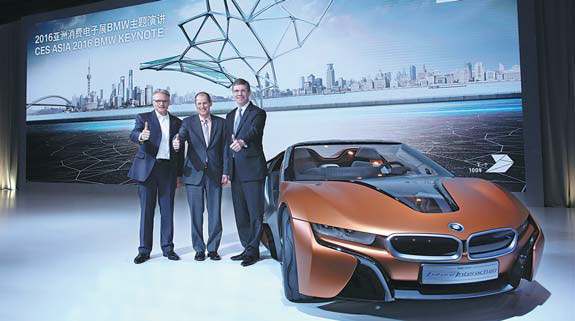German brand reflects on future of mobility at CES Asia
|
Olaf Kastner (right), president and CEO of BMW Group Region China, Gart Shapiro (center), president and CEO of the Consumer Technology Association, and Rene Wies, senior vice-president, Research and Development Center, BMW China Services Ltd, attend the Consumer Electronics Show Asia in Shanghai last week. |
German luxury car maker BMW highlighted its shift toward becoming a high-tech company, and demonstrated its connected vehicles and future gadgets at the Consumer Electronics Show Asia in Shanghai.
While celebrating its centennial this year, BMW Group has a clear vision of how to remain a leading provider of premium mobility solutions over the next 100 years.
"We do substantial scouting in the fields of technology, design, digitalization and of developments in society, in order to identify future trends and adjust our company strategy accordingly," Olaf Kastner, president and CEO of BMW Group Region China, said in his keynote speech at CES Asia on Thursday.
"Given the long development cycle for cars followed by multi-year product lifecycles afterwards, this is a prerequisite for future success. This is why we are not just looking back at the past 100 years, but are looking forward over the next 100 years."
Nowadays, the accelerating digitalization of automobiles is seen as disruptive for the existing automotive industry, as it is introducing new competition from technology companies.
"The world of mobility appears to be going through iconic changes once again other companies, many of them with digital roots, are joining the competition around e-mobility," said Kastner.
He said, BMW is likewise entering the tech field as it expands into the fields of highly autonomous driving, or HAD, digitalization and mobility on demand.
For instance, BMW presented its Mobility Mirror for the first time in China at CES Asia. It serves as both an ordinary mirror and an internet connected high-definition display.
Through the Mobility Mirror, one can control connected smart appliances at home. For example, a user can turn on or off the lighting system, check whether the windows and doors are shut, or set the security alarm. The mirror also allows the user to schedule and plan his or her route.
The BMW i Vision Future Interaction concept car brought a realistic embodiment of the future of driving to the exhibition, demonstrating what a sustainable and fully interconnected mobility car of the future looks like.
The concept car is a complete mobility eco-system and possesses all the prerequisites for fully autonomous driving, or FAD. It is linked to the web and provides comprehensive services that start at the user's home and includes autonomous parking at destinations.
BMW has been heavily involving in the future of HAD and FAD, and test cars have made the journey between the German cities of Munich and Nuremberg at speeds up to 120 km/h.
In China, BMW is cooperating with Baidu on a HAD project using cloud services and maps.
haoyan@chinadaily.com.cn
(China Daily 05/16/2016 page19)









